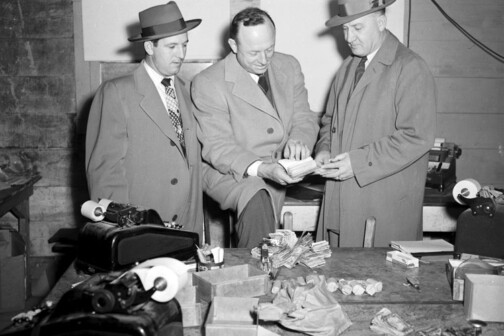George Dahl was one of the architects who built Dallas. He certainly was the drive behind Fair Park, leading the planning and construction of 26 Art Deco-style buildings ahead of the 1936 Texas Centennial Exposition. He divided the park into four sub-districts, centered upon the 700-foot-long Esplanade that led to the ornate Hall of State.
The Neiman Marcus building downtown, the First National Bank building, the Statler Hilton, the old Dallas Morning News ‘Rock of Truth’ building, the News’ new digs in the old library, WFAA’s low-slung modern structure next door—all Dahl.
Which is part of why this magazine commissioned the writer David Bauer to follow the messy family saga that capped off the end of his life. His daughter, Gloria, and her husband, Ted, asked a court for guardianship of the 83-year-old architect in 1978. The Akins didn’t believe him to be competent to manage his finances and other business, and were concerned that his decision to marry the younger Joan Renfro was fueled by her manipulation. Dahl argued that his family was coming after the trust belonging to his late wife, of which he was the sole trustee.
The Akins wanted a court to remove Dahl as the trustee, which ultimately failed. A lower court affirmed the decision. Ten years ago, when we featured this piece as part of our 40 greatest stories package, my former colleague Jason Heid dialed the Dallas lawyer and judge Ted Akin, Dahl’s son-in-law.
He called the decision “one of the most tragic miscarriages of justice,” one that “changed precedent that dated back to 1750 in England.” The ruling resulted in the dissolution of the trust, and Dahl took control of its millions of dollars. Akin argued that the judges were hemmed to a Supreme Court ruling that made it “easier for plaintiff’s lawyers bringing similar suits in the future than in the true merits of the case.”
Here’s how Jason summed up the end of Dahl’s life, in the years after Bauer’s story was published:
George Dahl died in July 1987, at age 93. Ted Akin says Dahl’s new wife Joan isolated him in the years before his death — especially after he suffered a second stroke that left him ailing and in a wheelchair — so that there was never any reconciliation. “You can’t patch things up if the person is held where you can’t get to them or even see them,” Akin says. The family was tipped off to the fact that Dahl was being hospitalized at Methodist just days before he passed away, and Gloria and their son, George, were able to get to Dahl there, the first time they’d seen him in ages. During that visit, he mistook his daughter Gloria for his granddaughter Laurel.
Akin presents a starkly different view of the events depicted in Bauer’s story. He still insists that Renfro was merely after Dahl for his money and that in the end, she got it all. The Akins received only family photographs as their inheritance. (Renfro died in 1996.) He’s convinced that the jurors in Dahl’s mental competency hearing had been paid off. And he’s certain that after Dahl’s first stroke in 1966 the famed architect became a different person, which led to their disagreements over the tax liability on funds withdrawn from the family trust and Dahl’s later suspicions of his family’s motives.
“It was a tragedy,” Akin says. “We lost all the way.”
Nevertheless, the story is one of the 50 greatest that we’ve published, and you can read it here.
Author







